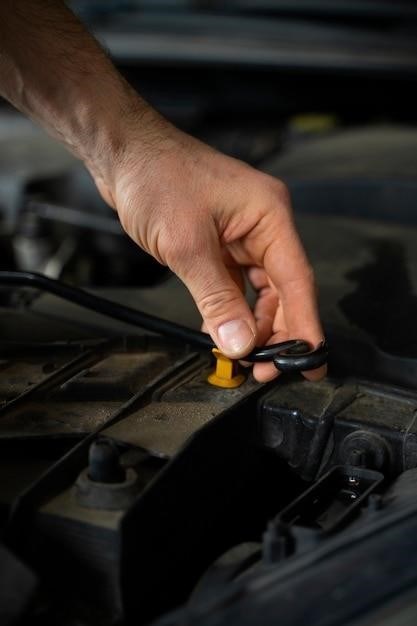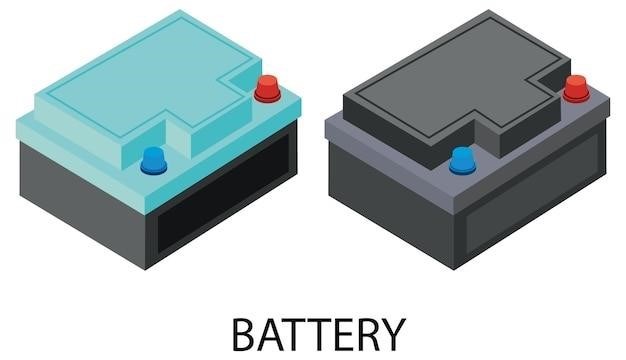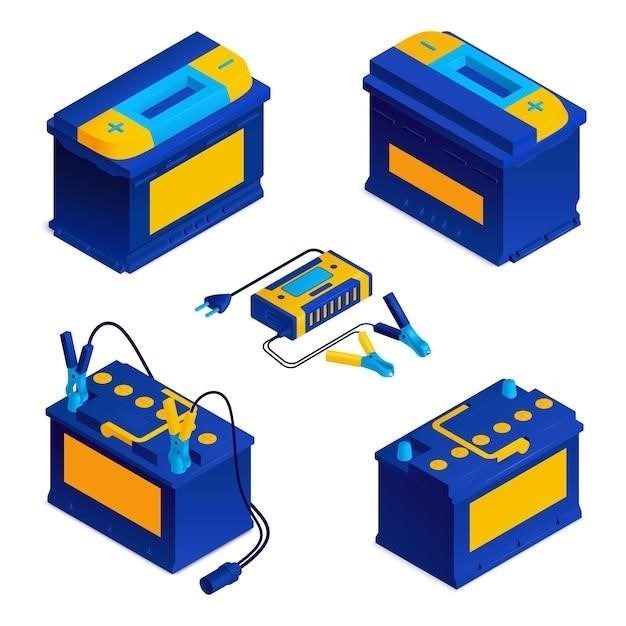noco boost pro gb150 manual

noco boost pro gb150 manual
NOCO Genius Boost Pro GB150⁚ A Comprehensive Guide

This guide provides a complete overview of the NOCO Genius Boost Pro GB150, a powerful 3000-amp lithium jump starter. Learn about its key features, jump-starting procedures, troubleshooting, safety precautions, and maintenance. We’ll cover battery charging, compatibility, and accessing online resources and support.
Introduction to the GB150 Jump Starter
The NOCO Genius Boost Pro GB150 is a compact and powerful lithium-ion jump starter designed for various vehicles, including cars, trucks, boats, and more; Its portability makes it ideal for roadside emergencies or situations where a traditional jump start might be difficult. This ultra-safe device boasts a peak current of 3000 amps, enabling quick and efficient jump starts for even high-displacement gas and diesel engines. Unlike many jump starters, the GB150 is equipped with advanced safety features to protect both the user and the vehicle’s electrical system. These features include spark-proof connections, reverse polarity protection, and short circuit protection. The GB150 also incorporates a built-in LED flashlight, proving useful in low-light conditions during roadside assistance. Its robust construction and high-capacity battery ensure reliability and longevity, making it a valuable tool for any driver or outdoor enthusiast. The user-friendly design allows for easy operation, even in stressful situations. This manual will guide you through the proper usage, maintenance, and troubleshooting of your NOCO Genius Boost Pro GB150 jump starter, ensuring its safe and effective operation.
Key Features and Specifications of the GB150
The NOCO Genius Boost Pro GB150 boasts several key features that set it apart. It delivers an impressive 3000 peak amps, sufficient to jump-start a wide range of vehicles, including those with larger engines. Its compact and lightweight design (2900g) ensures easy portability and storage. The integrated high-intensity LED flashlight is a valuable addition for nighttime use. Safety features are paramount, including reverse polarity protection to prevent accidental damage to the vehicle’s electrical system. The GB150 is also equipped with spark-proof connections and short-circuit protection, ensuring user safety. The device’s lithium-ion battery provides long-lasting power and a quick recharge time. Its robust construction is designed to withstand the rigors of everyday use. Dimensions are 185mm (W) x 68.58mm (D) x 315mm (H). The GB150 is compatible with 12-volt lead-acid batteries, making it suitable for most vehicles. Additional features may include a USB charging port for charging other devices. The device’s ultra-safe design incorporates multiple safety mechanisms to prevent accidental damage or injury. Consult the full manual for a comprehensive understanding of all safety precautions and operating procedures. Remember always to prioritize safety when using any jump starter.
Jump Starting Procedures⁚ A Step-by-Step Guide
Before beginning, ensure the GB150 is adequately charged. Consult the battery voltage and chemistry of your vehicle’s battery; this information should be in your vehicle’s owner’s manual. The GB150 is designed for 12-volt lead-acid batteries only. Turn off all accessories in the vehicle requiring power. Locate the vehicle’s battery and ensure it’s accessible and not damaged or frozen. Connect the positive (+) clamp of the GB150 to the positive (+) terminal of the vehicle’s battery. Then, connect the negative (-) clamp of the GB150 to an unpainted metal surface on the engine block, away from the battery. Avoid connecting to moving parts. Start the vehicle’s engine. Once started, immediately disconnect the GB150 clamps, beginning with the negative (-) clamp first, then the positive (+) clamp. Allow the vehicle’s alternator to recharge the battery. If the vehicle doesn’t start, check the connections, battery condition, and follow troubleshooting steps in the manual. Never attempt to jump-start a damaged or frozen battery, as this could be dangerous; Always refer to your vehicle’s owner’s manual for specific jump-starting instructions and safety precautions. This step-by-step guide is for general information only; always prioritize safety and consult the full NOCO GB150 manual for detailed instructions.
Troubleshooting Common Issues with the GB150
If the GB150 fails to jump-start a vehicle, first check the battery connections to ensure they are securely attached to both the vehicle’s battery terminals and the designated ground point. Verify that the clamps are correctly positioned on the positive (+) and negative (-) terminals, avoiding any accidental short circuits. Examine the GB150’s power level; if the battery is low, charge it fully before attempting another jump start. Ensure the vehicle’s battery is not damaged, frozen, or excessively discharged; a severely depleted battery may require professional attention. Inspect the GB150’s cables for any signs of damage or wear. If the cables are damaged, replace them immediately with NOCO-approved replacements to avoid safety hazards. Check the GB150’s LED indicators; these lights provide diagnostic information about the unit’s status and may pinpoint the source of the problem. If the problem persists after these checks, review the troubleshooting section in the NOCO Genius Boost Pro GB150 user manual for more detailed guidance and potential solutions. If you are still unable to resolve the issue, contact NOCO customer support for assistance.
Safety Precautions and Warnings for Using the GB150
Before using the NOCO Genius Boost Pro GB150, carefully read and understand all safety instructions provided in the user manual. Always wear appropriate eye protection and protective clothing when working near a vehicle battery. Never attempt to jump-start a damaged, frozen, or leaking battery; doing so can lead to explosions and serious injury. Ensure adequate ventilation when operating the GB150, as batteries produce explosive gases. Avoid contact with battery acid; in case of skin or eye contact, immediately flush the affected area with clean water and seek medical attention. Never allow children to handle the GB150 or its accessories; keep it out of their reach. Do not modify or repair the GB150 yourself; only use NOCO-approved parts and accessories. Always disconnect the GB150 from the vehicle battery before making any adjustments or repairs. Store the GB150 in a cool, dry place away from flammable materials. Do not expose the unit to excessive heat or moisture. Properly dispose of the GB150 battery at a designated recycling center according to local regulations. Remember, failure to follow these safety precautions may result in serious injury, death, or property damage. Always prioritize safety when working with automotive batteries and jump starters.
Understanding the GB150’s Manual Override Function
The NOCO Genius Boost Pro GB150 incorporates a Manual Override function, designed for situations where the automatic safety features might hinder the jump-starting process. However, it’s crucial to understand that activating Manual Override disables all safety features, increasing the risk of damage to the GB150 or the vehicle’s electrical system. Only use this function if absolutely necessary and you are fully aware of the potential risks involved. To activate Manual Override, press and hold the dedicated button for three seconds until the charge LEDs begin to cycle. While this may seem like a way to boost power, it does not actually increase the amperage output. This function should only be used as a last resort when other jump-starting methods have failed, and you have carefully assessed the situation. Improper use of Manual Override can lead to unexpected consequences, potentially harming the unit and even causing injury. Always refer to the complete user manual for detailed instructions and safety precautions before attempting to use this feature. Remember, safety should always be your top priority.

Maintaining and Caring for Your GB150
Proper maintenance ensures the longevity and optimal performance of your NOCO Genius Boost Pro GB150. Regularly inspect the unit’s casing for any signs of damage, such as cracks or abrasions. Examine the cables for wear and tear, ensuring the connections are secure and free from corrosion. Avoid exposing the GB150 to extreme temperatures, excessive moisture, or harsh environmental conditions. Store it in a cool, dry place when not in use. After each use, gently clean the unit with a damp cloth to remove any dirt or debris. Avoid using abrasive cleaners or solvents, as these could damage the surface. The GB150’s internal lithium-ion battery requires specific charging practices; always follow the manufacturer’s guidelines to prevent overcharging or deep discharging, which can shorten its lifespan. Periodically check the battery level indicator to monitor its charge status. Remember, proper care and maintenance will significantly extend the operational life of your NOCO Genius Boost Pro GB150 and ensure its reliability during emergencies.
Charging the GB150 Battery⁚ Best Practices
Optimizing your NOCO Genius Boost Pro GB150’s battery life involves understanding and implementing best charging practices. Utilize the included USB charging cable and a compatible NOCO 10W 12V power adapter. While third-party adapters might work, ensure they meet standards like EN 301489-34, IEC 62684, YD/T 1591-2009, CNS 15285, or ITU L.2000 for safety and optimal performance. Avoid using low-quality adapters, as these pose electrical risks. Charging with damaged cables or in moist conditions can lead to electric shock. To maximize battery longevity, avoid extended charging periods (over a week). Overcharging can reduce the battery’s lifespan. An unused GB150 will eventually discharge; recharge it before each use. Disconnect the unit from power sources when not charging. Always refer to the NOCO manual for detailed instructions and safety guidelines. Remember, adhering to these best practices ensures your GB150 remains a reliable power source for years to come. Ignoring these precautions might negatively impact battery health and could even void warranties.
Compatibility and Limitations of the GB150
The NOCO Genius Boost Pro GB150 boasts impressive capabilities, but understanding its compatibility and limitations is crucial for safe and effective use. Primarily designed for jump-starting 12-volt lead-acid batteries, it’s compatible with a wide range of vehicles, including cars, trucks, boats, and motorcycles. However, attempting to use it with other battery chemistries can be dangerous and may result in damage to the device or even injury. The GB150’s powerful 3000-amp output is suitable for most vehicles, but it’s important to consult your vehicle’s manual for specific jump-starting procedures and precautions. While the GB150 can handle batteries with voltage as low as 2 volts, extremely discharged or damaged batteries may not respond to jump-starting. Always check the battery’s condition and voltage before attempting to jump-start it. The GB150’s compact size makes it portable, but its capacity is limited; it’s not intended as a continuous power source for extended periods or high-power devices. Only use NOCO-approved accessories to avoid damaging the device or compromising safety. Refer to the complete manual for a detailed list of compatible battery types and limitations.
Using the GB150 with Different Battery Types
The NOCO Genius Boost Pro GB150 is specifically designed for jump-starting 12-volt lead-acid batteries. This is explicitly stated in the user manual and is a critical safety precaution. Attempting to use the GB150 with other battery types, such as lithium-ion batteries or different voltage systems, is strongly discouraged and could result in serious damage to both the GB150 and the battery being connected, as well as posing a risk of personal injury. The device’s internal safety mechanisms are calibrated for the specific chemical and electrical characteristics of 12-volt lead-acid batteries. Using it with incompatible batteries could bypass these safety features, potentially leading to overheating, explosions, or electrical shocks. Before using the GB150, always verify that the battery you intend to jump-start is a 12-volt lead-acid battery. Consult the battery’s own documentation to confirm its compatibility and proper jump-starting procedures. The manual emphasizes the importance of adhering to these guidelines to ensure both the safety of the user and the longevity of the GB150. If you’re unsure about the battery type, it’s best to err on the side of caution and avoid using the GB150.
Accessing the Full PDF Manual and Online Resources
For comprehensive instructions and detailed safety information, accessing the full PDF version of the NOCO Genius Boost Pro GB150 user manual is recommended. This digital manual often includes additional safety guidelines, warranty details, and compliance information (like FCC regulations) that may not be present in abridged versions. You can typically find this PDF on the official NOCO website through their support or product pages. Searching online using “NOCO Genius Boost Pro GB150 manual PDF” will likely yield direct links to the downloadable file. Beyond the PDF manual, NOCO provides various online resources to assist users. Their website may contain FAQs, troubleshooting guides, and video tutorials that cover common issues and provide step-by-step instructions for various functions. These supplementary materials can help users quickly resolve minor problems or gain a better understanding of specific features. Furthermore, NOCO’s website may offer contact information for their customer support team, allowing you to directly address any questions or concerns not covered in the manual or online resources. Utilizing both the complete PDF manual and NOCO’s online resources ensures a more complete understanding of the GB150’s capabilities and safe operation.
NOCO Customer Support and Warranty Information
NOCO typically offers robust customer support channels to assist users with any questions or issues related to their products, including the Genius Boost Pro GB150. Their website usually provides contact information, such as phone numbers, email addresses, and possibly a live chat option. This allows users to directly reach out to NOCO representatives for assistance with troubleshooting, technical questions, or warranty claims. The NOCO website might also feature a comprehensive FAQ section, addressing frequently asked questions about product usage, maintenance, and potential problems. This self-service resource can help users quickly find answers to common issues without needing direct contact with customer support. Regarding warranty information, the details are usually outlined within the product’s user manual and may also be available on the NOCO website. The warranty typically covers defects in materials and workmanship for a specified period. It’s crucial to understand the terms and conditions of the warranty to know what is and isn’t covered under the manufacturer’s guarantee. Understanding the warranty and accessing NOCO’s customer support resources ensures a positive user experience and facilitates prompt resolution of any difficulties encountered with the GB150.
Disposal and Recycling of the GB150 Battery
Proper disposal and recycling of the NOCO Genius Boost Pro GB150’s lithium-ion battery are crucial for environmental protection and safety. Never dispose of the battery in household trash; this is illegal in many jurisdictions due to the hazardous nature of lithium-ion batteries. The battery contains materials that can harm the environment if improperly discarded. Instead, follow the guidelines provided by NOCO or your local waste management authority for responsible battery disposal. Many communities offer battery recycling programs at designated collection centers, often found at electronics retailers, recycling facilities, or municipal waste disposal sites. These programs allow for the safe and environmentally sound recovery of valuable materials from the battery. Alternatively, NOCO may provide a battery take-back program or partner with a recycling service to facilitate the return and proper disposal of used batteries. Check NOCO’s website or contact their customer support for details on their specific recycling program. Following the correct procedure ensures that hazardous materials are handled appropriately, preventing environmental damage and protecting public health. Remember to always consult local regulations for any specific requirements regarding the disposal of lithium-ion batteries in your area.